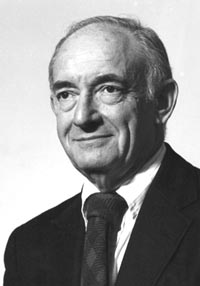In Memoriam: Eugene L. Saenger
1917-2007
by James G. Kereiakes

Eugene L. Saenger, MD, professor emeritus of radiology at the University of Cincinnati College of Medicine, died at the age of 90 of natural causes on 30 September 2007.
Saenger contributed to the establishment of the Cincinnati Radiation Society (CRS) in 1954. He served as president of the CRS, was a member of the Health Physics Society (HPS) Board of Directors from 1966 to 1969, and was an HPS Fellow.
Saenger was an internationally renowned physician, scientist, investigator, and teacher who made fundamental contributions to medicine and the specialty of nuclear medicine, yet described himself as "just a simple country doctor." His maternal uncle, Sidney Lange, MD, was professor of radiology and the first chairman of the Department of Radiology at the University of Cincinnati.
Saenger attended Walnut Hills High School and was accepted to college after his junior year. He received an AB degree cum laude from Harvard University in 1938 and his MD degree from the University of Cincinnati College of Medicine in 1942. He completed his internship and residency at the Cincinnati General Hospital and was certified by the American Board of Radiology in 1946. A pioneer in the field of nuclear medicine, he was, in 1972, among the first persons in this field to be certified by the American Board of Nuclear Medicine.
Saenger devoted the bulk of his professional career to the University of Cincinnati. He established the hospital's radioisotope laboratory in 1948 and it was named the Eugene L. Saenger Radioisotope Laboratory in his honor in 1979. Upon his retirement in 1987, at which time he was appointed professor emeritus, the Eugene L. and Sue R. Saenger Professorship in Radiological Sciences was established.
A major theme of Saenger's distinguished career was the responsible use of radiation in medicine. He organized studies for the Bureau of Radiological Health that demonstrated that radioiodine could be used for treating hyperthyroidism without a significant risk of inducing thyroid carcinoma. He was also a pioneer in demonstrating that nuclear medicine procedures could be safely performed on children. He was one of the first radiologists to use bone-marrow transplantation on irradiated patients. During the 1970s, he became a leader in analyzing the efficacy and risk-versus-benefit considerations in medical uses of radiation. He was also an early advocate of the use of computers in the compilation and analysis of data collected on patients in nuclear medicine procedures.
He was a founder and first president of the Society for Medical Decision Making in 1978, the primary goal of which was to promote analysis of the efficacy of medical procedures.
Saenger served as a consultant in the areas of radiology and radiation protection to numerous governmental and private organizations. After the Chernobyl reactor incident, he consulted with the government on whether to evacuate military and civilian personnel from Eastern Europe.
Saenger made many valuable contributions to professional societies, including the Society of Nuclear Medicine (SNM), for which he served as an associate editor of the Journal of Nuclear Medicine from 1960 to 1970, the American College of Radiology, the Radiological Society of North America (RSNA), the American Roentgen Ray Society (ARRS), the American Medical Association, the Health Physics Society, the Society for Pediatric Radiology, and the National Council on Radiation Protection and Measurements (NCRP). For NCRP he served in several appointments, including five NCRP scientific committees and as chairman of committees that prepared Report No. 40 on "Protection Against Radiation from Brachytherapy Sources" (1972) and Report No. 55 on "Protection of the Thyroid Gland in the Event of Release of Radioiodine" (1977).
In recognition of his contributions to the advancement of nuclear medicine, Saenger received many honors and awards. In 1968 he was invited to deliver the Annual Oration of the RSNA, and in 1982 he presented the Lauriston S. Taylor Lecture on the topic of "Ethics, Trade-Offs and Medical Radiation" at the NCRP annual meeting. In 1987 he was awarded the SNM von Hevesy Nuclear Medicine Pioneer Award for his outstanding achievements, and in 1993 he received the prestigious Gold Medal Award of the RSNA. In 1998 he was awarded the ARRS Gold Medal for lifetime achievements. In 1988 Saenger received the University of Cincinnati College of Medicine's Daniel Drake Award. He published over 200 articles and book chapters and gave more than 50 invited or named lectureships.
Saenger is survived by a son, Eugene L. Saenger Jr. of Cincinnati, four grandchildren, and two great-grandchildren. His wife, Sue Reis Saenger, and a daughter, Katherine Soodek, died earlier. His family has requested that donations in Dr. Saenger's name be made to an organization of one's choice. Eugene Saenger will be greatly missed and remembered with admiration by his family and many colleagues and friends throughout the world.




